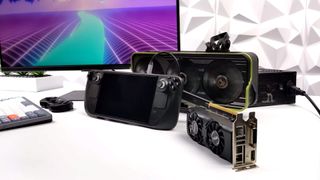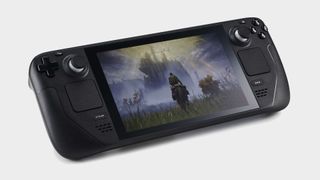Upgrade your Steam Deck's GPU by turning it into a jury-rigged monstrosity
Using a simple M.2 > PCIe adapter you can plumb even an RX 6900 XT into Valve's handheld PC. But it's not exactly... practical.

Turns out you actually can upgrade the graphics in Valve's Steam Deck with an off-the-shelf GPU. So long as it's an AMD Radeon card, and you don't mind pulling the SSD out of its slot, you can get up to ten times the gaming performance of the stock Aerith APU.
The Steam Deck is a full gaming PC. That's something Valve has been keen to talk about since revealing its handheld gaming PC. And what do you do when your gaming PC doesn't have enough graphical grunt? You strap a new graphics card to it, which is exactly what YouTube channel, ETA Prime, has just done.
This isn't the first time someone's plumbed a new GPU into their Steam Deck; UFD Tech had an RX 6600 XT running in one it picked up off Ebay for a likely offensive sum of money. But ETA Prime went further, a lot further, and has managed to plug an ASRock RX 6900 XT OC into one of Valve's handheld beasties.
Now, you may be asking how they got a desktop GPU into the confines of the Deck, and the answer is they obviously didn't. But neither did they use an external graphics card dock. That's because the Steam Deck has no Thunderbolt connection, just USB Type-C. That's a real shame, but what it does have is an M.2 PCIe connection for its SSD.
As it's essentially still just a x4 PCIe 3.0 slot you can use a simple adapter to wire a desktop GPU into the inner workings of your Deck. Unfortunately that does necessitate removing any SSD storage you have in there previously, and also means you have to boot from the SD card slot.
Currently that precludes using SteamOS 3.0 as it still isn't available to be installed to an external drive. But you can install Windows onto an SD card, and that will let you boot your Deck with a full desktop graphics card plugged into the SSD slot.
It's a real jury rigged setup, and because the RX 6900 XT GPU is a thirsty slice of silicon ETA Prime has a whole desktop power supply dedicated to running the AMD card. A portable solution this ain't.
The biggest gaming news, reviews and hardware deals
Keep up to date with the most important stories and the best deals, as picked by the PC Gamer team.
In terms of performance the 3DMark Time Spy score leapt from 1,722 with the standard AMD Aerith APU in the Deck, up to 10,395 with the RX 6900 XT powering things. That's a massive increase in performance, as you would hope and expect. And the same was true in games, where they were able to get the likes of Witcher 3 at over 100 fps at 4K ultra settings, and over 60 fps in GTA V at the same resolution and ultra settings.

Steam Deck review: Our verdict on Valve's handheld PC.
Steam Deck availability: How to get one.
Steam Deck battery life: What's the real battery life of the new device?
How loud is the Steam Deck? And will it pass the Significant Other test?
Steam Deck - The emulation dream machine: Using Valve's handheld hardware as the ultimate emulator.
But the Aerith APU is an inevitable bottleneck for the GPU, with modern games, such as Cyberpunk 2077, God of War, and Elden Ring struggling for anything like decent RX 6900 XT levels of performance, even with graphical settings dialed way back.
That's not a surprise, though, and does highlight how tightly specced the Deck's overall hardware is to its price/performance level.
So, now graphics cards are plentiful and 'affordable', is there a future where Valve releases a Deck with the option for an external GPU to plug into it? Oh, hell no.
These are just interesting experiments that show what you can do with Valve's handheld hardware, not what anyone should be doing. The Steam Deck is a portable gaming device, and a surprisingly versatile PC, but without a Thunderbolt connection it's certainly no basis for a big gaming rig with a beefy external GPU.
Fun though, eh?

Dave has been gaming since the days of Zaxxon and Lady Bug on the Colecovision, and code books for the Commodore Vic 20 (Death Race 2000!). He built his first gaming PC at the tender age of 16, and finally finished bug-fixing the Cyrix-based system around a year later. When he dropped it out of the window. He first started writing for Official PlayStation Magazine and Xbox World many decades ago, then moved onto PC Format full-time, then PC Gamer, TechRadar, and T3 among others. Now he's back, writing about the nightmarish graphics card market, CPUs with more cores than sense, gaming laptops hotter than the sun, and SSDs more capacious than a Cybertruck.
Most Popular






